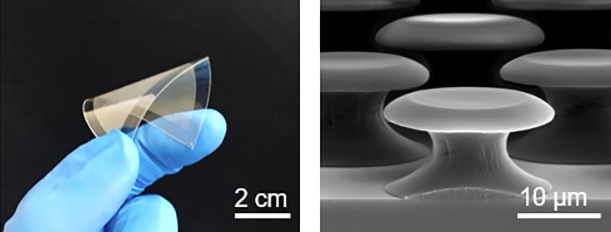Mushroom-shaped microstructures give this new adhesive an almost unbreakable bond in wet environments, making it ideal for use in medicine and engineering.
According to Professor Hoon-Eui Jeong from the School of Mechanical Aerospace and Nuclear Engineering at the Ulsan National Institute of Science and Technology (UNIST) in South Korea, this new adhesive has advantages over the natural glues used by shellfish and the man-made substances derived from them.
For example, it’s easy to remove when it dries out and doesn’t require the other surface to be chemically treated beforehand.
“In contrast to other wet binding systems, the current interlocking mechanism does not involve any complicated surface treatment or chemical moieties [molecular parts], thus allowing for a simple yet efficient route to strong and reversible wet adhesion in a cost-effective manner,” Jeong explained.
Powerful microhooks
Jeong’s adhesive owes its sticking power to mushroom-shaped “microhooks” about 10 micrometres in width and height.
His research team, whose research was published in ACS Macro Letters, produced their glue from hydrogel films. These films have the tiny microhook structures on each of their surfaces, and when they are brought into contact, the microhooks on each surface interlock.
When wet or moist, the microhooks swell and can’t be budged. When dry, they shrink and can be readily pried apart. The researchers said the degree of swelling could be varied with the molecular weight of the hydrogel used.

The study did not describe how the hydrogel layers would be attached to the materials being glued together, but suggested the adhesive’s properties could make it suitable for wet applications such as bio-medicine or repairs to underwater equipment where chemical adhesives are ineffective.
Inspired by nature
Developers of other wet adhesives (or those with the ability to stick underwater) have drawn inspiration from nature in the past.
Last year, US scientists based an underwater glue on the ability of mussels to adhere to underwater surfaces using miniature hairs coated in an amino acid called DOPA. Compounds within this amino acid, known as catechols, do not react with water like other chemical adhesives, but are able to bond to other materials in spite of wet conditions.
The researchers added catechols and other mussel proteins to a polymer to create an adhesive that gripped around 17 times as strongly as the mussel’s glue.
Whether based on nature or hydrogels, underwater adhesives look like they will be sticking around as researchers work to find the optimum formula.
